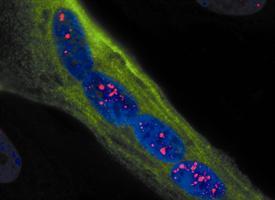It’s too soon to know whether the approach will work in patients.
Scientists have reversed symptoms of myotonic muscular dystrophy in mice by eliminating a buildup of toxic RNA in muscle cells. The work, carried out by scientists at the University of Rochester Medical Center, Isis Pharmaceuticals Inc. and Genzyme, is published in the August 2 issue of Nature.
After experimental antisense compounds were administered to mice twice a week for four weeks, symptoms of the disease were reduced for up to one year – a significant portion of a mouse’s lifespan.
The investigators say that while the work is an encouraging step forward against myotonic dystrophy, one of the most common forms of muscular dystrophy, it’s too soon to know whether the approach will work in patients. But they are cautiously optimistic, noting that the compound is extremely effective at reversing the disease – whose genetic underpinnings make it particularly vulnerable to an antisense approach – in a mouse model.
“These results give us strong encouragement about the possibility of developing a treatment that could fundamentally alter the disease. It’s an important step on a long path,” said senior author Charles Thornton, M.D., a neurologist at the University of Rochester Medical Center who has been pursuing new treatments for the disease for more than two decades.
“But, it’s too early to know if this treatment will work as well in people as it did in the laboratory. Unfortunately, in biomedical research there are previous examples of compounds that worked in mice but not in people,” added Thornton, the Saunders Family Distinguished Professor in Neuromuscular Research.
About 35,000 Americans have myotonic dystrophy, an inherited disorder that is marked by progressive muscle weakness and stiffness; eventually many patients have difficulty walking, swallowing, and breathing. The disease can also affect the eyes, the heart, and the brain. While there are medications to treat some of the disease symptoms, there is no drug to stop its progression.
via University of Rochester Medical Center
The Latest Streaming News: Muscular Dystrophy Treatment updated minute-by-minute
Bookmark this page and come back often
Latest NEWS
Latest VIDEO








